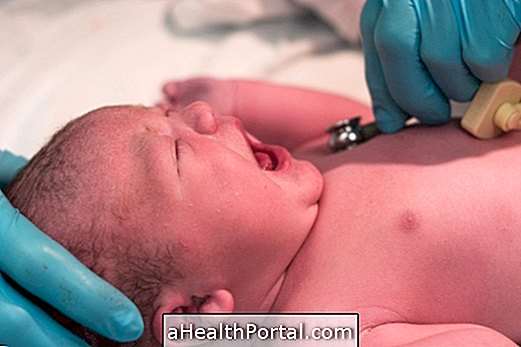The omphalocele corresponds to the malformation of the abdominal wall during the process of fetal development, being noticed the presence of organs, such as intestine, liver and spleen, outside the abdominal cavity.
This congenital disease can be diagnosed between the 8th and 12th gestation by means of imaging studies performed during pregnancy and the early diagnosis is efficient regarding the preparation of the medical staff for the childbirth because it is likely that the baby will be submitted to surgery after birth to put the organ in its correct place, avoiding complications.

Main causes
The cause of the omphalocele is not yet very well established, however it occurs during fetal development and can happen due to the change in the positioning of the intestine, remaining in the external part of the abdominal cavity. In some cases, it may still be noted not only the intestine out of the abdominal cavity, but also other organs, especially liver and spleen. These organs are covered by a membrane, which, if broken, can result in serious infectious processes.
In some cases, omphalocele may also be related to genetic alterations, being considered not only a congenital disease, but also genetic.
How is the diagnosis
The omphalocele can be diagnosed during pregnancy, especially between the 8th and 12th pregnancies, by means of the ultrasound examination. After birth, the omphalocele can be perceived through the physical examination performed by the physician, in which the presence of organs outside the abdominal cavity is observed.
After assessing the extent of the omphalocele, the physician determines the best therapeutic approach, and the surgery is performed immediately, when small, or in stages, when the omphalocele is extensive. In addition, the doctor can perform other tests, such as echocardiography, x-rays and blood tests, for example to check for other diseases, such as genetic alterations, diaphragmatic hernia and heart defects, for example.
How is the treatment done?
The treatment is done through surgery, which can be done right after birth or after a few weeks or months according to the extent of omphalocele, other health conditions that the baby may have and prognosis of the doctor. It is important that the treatment is done as soon as possible to avoid possible complications, such as intestinal tissue death and infection.
Thus, when it is a minor omphalocele, that is, when only a portion of the intestine is outside the abdominal cavity, surgery is done soon after birth and aims to place the organ in the correct place and then close the abdominal cavity .
In the case of severe omphalocele, that is, when not only the intestine but also the liver and spleen are out of the abdominal cavity, the surgery is done in stages so as not to hinder the development of the baby. This is because if all organs are placed at one time, the baby's abdomen may not hold. The abdominal cavity is also closed by surgery after all organs are placed inside the abdominal cavity.
In addition to surgical removal, the physician may recommend that an antibiotic ointment be carefully placed in the pouch lining the exposed organs in order to reduce the risk of infection, which can be serious especially when the membrane lining the organs is broken.




















